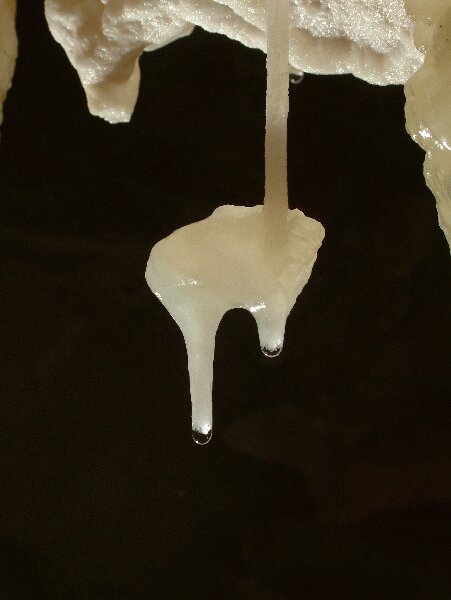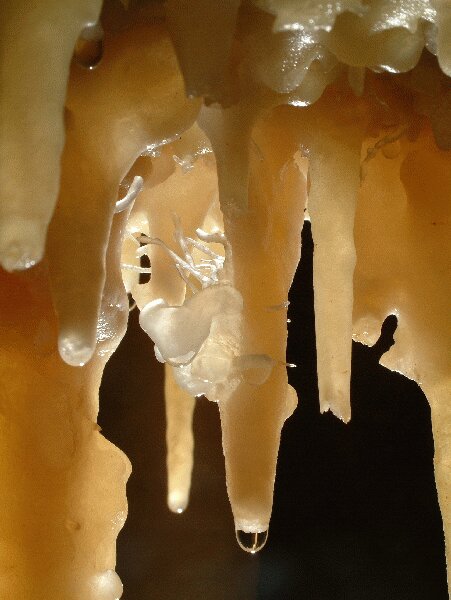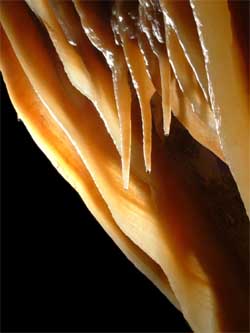Cave Palvolgyi EarthCache
-
Difficulty:
-

-
Terrain:
-

Size:  (not chosen)
(not chosen)
Please note Use of geocaching.com services is subject to the terms and conditions
in our disclaimer.
|
| The pálvölgy cave opening on the
northern side of Rózsadomb was discovered in 1904 when a new quarry
was opened to provide the expanding city with stones. At the
beginning of the century only a few km section was known out of the
rambling cave consisting of several levels above one another, but
at present more than 18 km of it is explored by cavers. In addition
one of its branches ends just a few meters from the neighbouring
Mátyás cave, which renders it probable that the two caves
constitute one system. The connected system of caves under the
Rózsadomb depositing onto triassic limestone took shape in eocene
limestone which is very prone to develop karst formations. Later,
in the course of volcanic activities the spouting up thermal waters
started to dissolve this layer of limestone along the tectonic
fault-fissures and widened them into hollows, tunnels, rooms.
Therefore, in these caves the visitor can see mainly formations
shaped with dissolving. dripstones made by water infiltrating down
from the surface is less typical. |
 |
Though the pálvölgy cave is not
a dripstone cave, the most dripstone formations can be found here
among the caves in Buda.
Besides the spheroid and concave formations, larger and smaller
niches made by hot water, in this cave there are relatively a lot
of dripstone columns growing from the ceiling towards the ground
and others starting from the ground and growing upwards. the
calcified frames of moss animals, shells of the eocene sea can be
seen at many places in the walls of the cave.
The biggest room of the 500 m long well maintained section of the
cave is called 'Theatre', which indeed has excellent acoustics.
Visitors can also see the unfathomable 'Radium room', the
enchanting dripstone formations of the 'Fairyland' and the
'Witches' kitchen'.
You can enter to the cave, for a guided tour please keep in contact
with them
Tel: +361-325-9505
E-mail: palvolgyi@t-online.hu
To log yor visit, please
1. Send me your answears to the following questions via
e-mail.
a. Who was the explorer of this cave?
b. How many rooms are in this cave - take a look to the
map?
c. Why are in there calcified animals in the
cave?
2. Upload a photo with you and a GPS from the header
coordinates
Happy caching! |
|



|
|
 |
A Rózsadomb északi oldalán nyíló
Pálvölgyi-barlangot 1904-ben fedezték fel, amikor a terjeszkedo
város koszükségletének fedezése érdekében újabb kobányát nyitottak
a város határában. A század elején még csak nagyjából egy
kilométeres szakasz vált ismertté a zegzugos, egymás fölötti
járatokból álló barlangból, de mára már több mint tíz kilométer
hosszan tárták fel a barlangászok. Ráadásul egyik ága csak pár
méterre ér véget a szomszédos Mátyáshegyi-barlangtól, ami azt
valószínusíti, hogy a két barlang talán egy rendszert képez.
A Rózsadomb alatt kialakult összefüggo barlangrendszer, a triász
mészkore kiülepedo, jól karsztosodó eocén mészkorétegben alakult
ki. A késobbi vulkanikus tevékenység során feltöro hévizek ezt a
mészkoréteget kezdték el a tektonikus repedések mentén kioldani, és
üregekké, járatokká, termekké szélesíteni. Ezért ezekben a
barlangokban inkább oldódási formákkal találkozhat a látogató, a
felülrol bejutó víz által létrehozott cseppkövek itt kevésbé
jellemzoek.
|
Bár a Pálvölgyi-barlang sem
cseppkobarlang, a budaiak közül mégis ebben a barlangban
találkozhat a látogató a legtöbb cseppkoképzodménnyel.
A meleg víz által létrehozott gömbszeru és homorú formák,
kisebb-nagyobb fülkék mellett itt viszonylag sok, a tetorol lefelé
növekedo és a talajról felfelé induló cseppkooszlop látható. A
barlang falában több helyen is látható az eocén kori tenger
mohaállatkáinak, tengeri kagylóinak elmeszesedett váza.
A barlang mintegy ötszáz méteres jól kiépített szakaszának
legnagyobb terme a valóban jó akusztikájú Színházterem. A látogatók
ezen kívül megcsodálhatják a "feneketlen mély" Rádium-termet,
valamint a Meseország és a Boszorkánykonyha varázslatos
cseppkoképzodményeit. 500 méteres, megújult túraútvonala sok
izgalmat tartogat. Meseszeru cseppkövek, különleges
szikla-alakzatok évezredek óta változatlan, megdermedt világába
visz el, ahol még a homérséklet is állandó: egész évben 11 C fok
körül alakul. A kiépített túraútvonal a legjellegzetesebb
szakaszokon vezeti végig a látogatót. A barlangtúra során
változatos cseppköveket, gömbszeru hévizes oldásformákat, csillogó
kalcitkristályokat, és osi kagylólenyomatokat csodálhatunk
meg.
A barlang látogatható részében túrák indulnak, elozetes egyeztetés
szükséges
Tel: +361-325-9505
E-mail: palvolgyi@t-online.hu
A megtaláláshoz kérlek,
1. Válaszolj az alábbi kérdésekre e-mailban.
a. Ki, vagy kik fedezték fel a barlangot?
b. Hány feltárt, megnevezett terem, folyosó, ág stb.
található a barlangban - térkép alapján?
c. Miért vannak megkövesedett állatok a
barlangban?
2. Tölts fel képet magadról egy GPS-sel, melyet a megadott
koordinátán készítettél
Sikeres vadászatot! |

Additional Hints
(Decrypt)
Gnxr n ybbx ng gur rknzcyr sbgb.../Irff rtl cvyynagáfg n zvagnsbgóen...